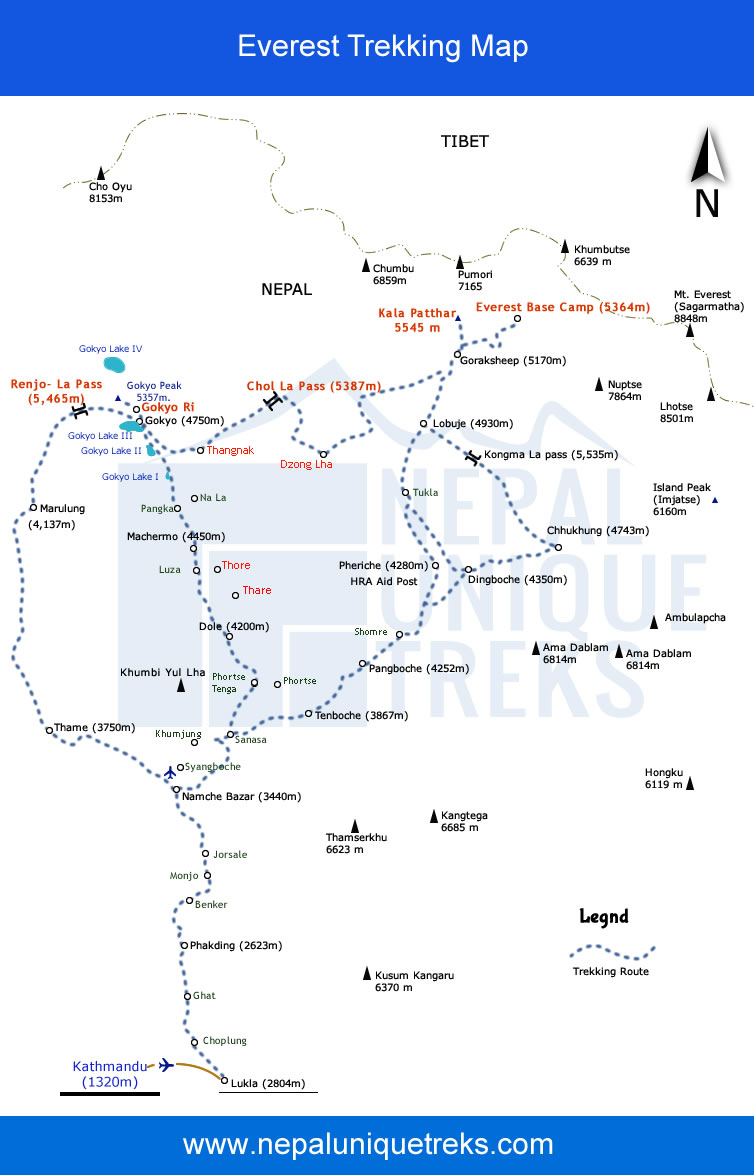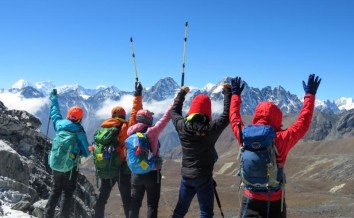Explore the ultimate adventure with our 18-day Everest Base Camp trek & Island Peak climbing package for 2025/26. Experience breathtaking Himalayan views, expert guides & seamless logistics. Book now for an unforgettable climb. Most trekkers look forward to Trekking to The Everest Base Camp and completing their journey. However, there is much more than just trekking. Taking up once in a once-in-a-lifetime opportunity with a challenge to summit the peak and experience the real mountaineering. This is what you will get in Everest Base Camp with Island Peak Climb Trekking.
This trek is not for a beginner who wants to trek and climb a peak in over 2 weeks. This is for trekkers who are willing to explore much more than just trekking in the Himalayas and take up a challenge to conquer the Island Peak. This can also be a great opportunity to experience real mountaineering in the Himalayas. And not to forget, the journey is challenging yet it's much more rewarding with all the panoramic and scenic views.
The trek to Everest Base Camp with Island Peak Climbing begins with a flight to the Lukla, the Gateway to Everest, and then a trek to Phakding. Moving further, traversing through the local community, exploring the Sherpa culture, and acclimatizing at different altitudes we reach the Everest Base Camp. From there, we navigate to get a closet view of Everest from Kalapatthar's viewpoint. Finally, with some basic training from the sherpas and guides, we will climb Island Peak and retrace our way back to Kathmandu.
Furthermore, explore the wilderness in the Himalayas, with diversified floras and faunas. Trekking on rugged terrains, with multiple uphills and downhills with fresh ample air and picturesque views of the mountain peaks, terrace fields, and hills. It will be more than just a journey, a way to enjoy yourself out in nature far away from all the hustle and bustle. Read the complete package to understand about the Everest Base Camp Trek with Island Peak Climbing trail.
Everest Base Camp Island Peak Climb Trekking Highlights
-
A mixture of trekking on Everest Base Camp with adventurous climb on the Island Peak.
-
Indulge yourself into experiencing the culture and tradition of the local community.
-
An adventurous flight to the Gateway to the Everest, Lukla Airport.
-
Traverse through the Capital of Sherpa, Namche Bazaar.
-
Get a closet and unobstructed view of Mt. Everest from Kalapatthar.
-
Experience the thrill and challenges of trekking in the Himalayas.
-
Explore diversified floras and faunas along the trail.
Why choose us for this trek?
Nepal Unique Treks is a professional & Government-authorized Trekking Agency that has been providing organized adventure trips all over Nepal. We have some of the best teams that will make sure that you have a great trip without any hassle in every possible manner. Moreover, the guides we have in the team are government license holders and have been in this sector for over a decade.
For the past 20 years, Nepal Unique Treks has been helping domestic as well as international trekkers plan and organize their dream journeys. Our teams and the local networks all over the country have enabled us to provide the best services in every region.
We provide these services not only in Nepal but also in Bhutan and Tibet. You can customize the itinerary according to your preferences, and we will proceed accordingly on this journey. Below are some additional information on why we are the perfect choice for Everest Base Camp Island Peak Climbing:
-
Designing exceptional itineraries, organizing logistics, and providing knowledgeable guides are our core strengths.
-
Prioritizing the best experience in the entire journey, we ensure to provide you the best services in every meal served and place accommodated.
-
Our guides have knowledge and network in multiple regions enabling an extra layer of convenience and support in the trek.
-
Skilled and experienced guides will help you from the very beginning of the trek ensuring a better journey.
Permits required for Everest Base Camp Island Peak Climb
While ascending on any trekking route, we need to pass through some protected areas. Passing such locations requires the trekkers to have specific permits or passes. Upon arrival at such destination, the officials will verify our permits and only then we are allowed to enter the area. Therefore, it is crucially important to have a permit for this journey. In addition, there is a special permit, Trekker's Information Management System (TIMS) Permit which allows the government officials to track the trekkers for their well-being and safety.
For Everest Base Camp Island Peak Climb Trekking we require the following permits:
1. Sagarmatha National Park Entry Permit
2. Khumbu Pasang Lhamu Municipality Entry Permit
3. Island Peak Climbing Permit
4. Trekker's Information Management System (TIMS) Permit
Sagarmatha National Park is a protected area which is established by the Government of Nepal to protect the flora and fauna of this region. And, on our journey, we have to pass through the national park. So, we require a Sagarmatha National Park Entry Permit. Similarly to support the local community of the Khumbu Region and contribute towards the local developmental projects and infrastructures, we require a Khumbu Pasang Lhamu Municipality Entry Permit.
In addition, a permit is required to climb the Island Peak, which can be obtained from the Nepal Mountaineering Association (NMA). Moreover, it also allows monitoring of the trekkers for their safety within the protected areas. Finally, issued by government officials a TIMS Permit is a special type of permit that helps the government official track the trekkers ensuring their safety and well-being.
In Nepal Unique Treks, we help you to get these permits without any hassle. Let us streamline the process for getting these permits while you prepare for the trek.
Why Insurance is necessary for Everest Base Camp Island Peak Climb Trekking Package?
Trekking up in the Himalayas consists of multiple risks. According to the situation, there might be cases where the trekkers require emergency evacuation or medical attention. During these scenarios, insurance can become a lifesaver for you.
There are different kinds of insurance you can get before starting this journey. Some of them provide medical coverage, emergency evacuation, cancellation insurance, and many more. However, we highly recommend you take the insurance package that covers all of these.
Even though we will be scheduling our journey in a most favorable season like Spring and autumn seasons. However, there is still a possibility of some changes in the weather. A sudden change in weather can disrupt our entire trek and can lead to other emergencies as well. Therefore, to ensure things go smoothly even in emergency cases, we recommend you get the full package of insurance.
Furthermore, our guides will always be there to assist and navigate you even in emergency cases. This way we can ensure you have a great journey with all the safety. Therefore, we recommend all trekkers obtain travel insurance before ascending the Everest Base Camp Trek with the Island Peak Climbing Package.

 WhatsApp
WhatsApp  Plan Your Trip
Plan Your Trip











 US$2450
US$2450 
.jpg)















Jasmine EmilyUnited StatesOn 2016-05-07
(Excellent)
Climbing Island Peak with Nepal Unique
April 10-22, 2016 Island Peak summit. Lifetime superb experience in every way, from experiential, logistic, and value standpoints. I would highly recommend Nepal Unique Treks for any high-altitude trekking and peak climbing trip in Nepal that they offer. I would pick them again if I have a chance to visit Nepal - and for future climbs.
Pre-trip information and communication are impeccable, thorough, and timely. Prices for the trek to Everest Base Camp and climbing expeditions were all very, very reasonable. The company leadership Dil Gurung and all staff are very responsible. They provide extra basic medication for altitude so that I feel so secure during the trip. I had a terrible cough / worst-URI-of-my-life throughout most of the trip and the staff took good care of me. Highly recommend Nepal Unique Treks.
Mr ANG GEK JOOSingaporeOn 2022-09-07
(Excellent)
Memorable Adventure with Nepal Unique Treks
I just want to say thanks so much to all the crew who made my trip one of the best I have ever had in my life.
One of my best friend travel partner and I did the Everest Base Camp trek and climbed Island Peak with Nepal Unique Treks team. I can only say they made the trip awesome. Again Thank you so much Dil for your best job and taking care of us.
We wish we come back again for another adventure hope we can make success again together with Dil. Highly recommended Nepal Unique Treks and Dil Gurung.
Anh QuanVietnamOn 2019-09-07
(Excellent)
EBC and Island Peak Summits with Friends
I am Anh Quan and with other friends, teamwork for Nepal Unique Treks to guide and support our efforts to trek Everest Base Camp and Island Peak ( Imja Tse) in the Sagarmatha National Park of Nepal. Nepal Unique Treks provided pre-mission advice Accommodation, technical training, and guidance in order to allow our team to reach the summit of Island Peak 6189 m p. The quality of service provided by Nepal Unique Treks. All team was extremely high and of a professional standard.
In particular, they showed immense care and motivation toward our endeavor to rich the top and complete the trip.
Without their help and guidance, it is clear that we would not have Everest Base Camp and Island Peak summit. I highly recommend Nepal Unique Treks and Dil Gurung to any individual or group that may wish to climb, Trekking, Tours, and Hiking in Nepal
Kim LienVietnamOn 2022-11-09
(Excellent)
Lifetime Experience in Nepal
My bucket list has long included climbing Island Peak and trekking to Everest Base Camp. Several COVID delays caused my journey. The wait was absolutely worth it! My desire was realized thanks to Nepal Unique Treks. The Island Peak Climbing experience left a lasting impression on us. The porters and guides were exceptional, offering helpful advice on how to handle the altitude in particular. They made sure we were climbing at a steady rate that would allow for adequate acclimatization. We enjoyed our meals and spent as much time as we could around the wood furnace to remain warm. The lodging was excellent. The trip was fantastic!